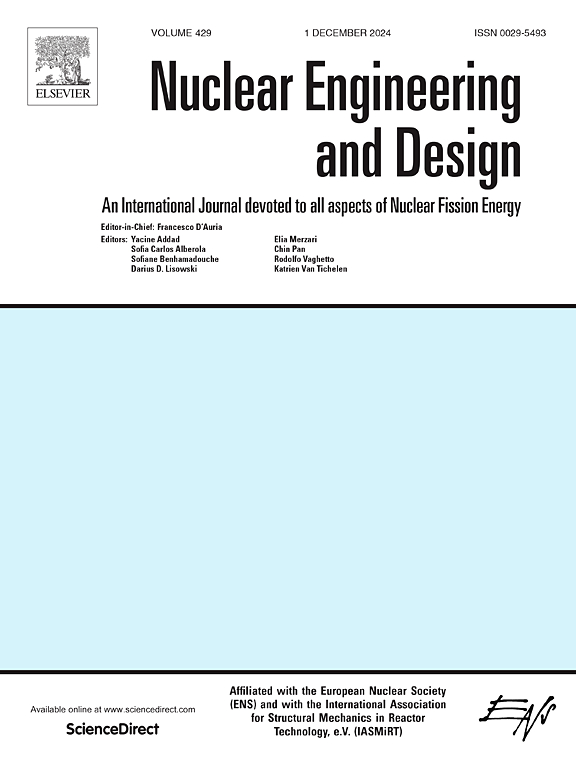高温高温堆压力容器在几种典型瞬态工况下的概率断裂力学分析
IF 2.1
3区 工程技术
Q1 NUCLEAR SCIENCE & TECHNOLOGY
引用次数: 0
摘要
概率断裂力学(PFM)在轻水堆压力容器结构完整性评价中的应用越来越广泛。对于高温气冷堆(HTGR)来说,其RPV的工作负荷在温度、压力、瞬态和快中子通量等方面都与轻水堆不同。此外,与RPV相关的安全要求也存在差异。本文对290mw球床模块化高温堆在几种典型瞬态工况下的RPV进行了PFM分析。为了模拟不同ASME规则下RPV的制造条件,假设RPV沿壁厚的缺陷信息具有不同的制造质量水平。此外,还研究了RPV中不同类型和区域的缺陷对初始条件概率(CPI)和失效条件概率(CPF)的贡献。数值计算结果表明,即使在缺陷尺寸的保守假设下,由于快中子通量水平低和瞬态发展缓慢,HTGR RPV的CPF也非常低。本文章由计算机程序翻译,如有差异,请以英文原文为准。

Probabilistic fracture mechanics analysis of a HTGR reactor pressure vessel under several typical transient conditions
Probabilistic fracture mechanics (PFM) has been increasingly used in the structural integrity evaluation of reactor pressure vessels (RPVs) in light water reactors (LWRs). For high temperature gas-cooled reactor (HTGR), the working load of its RPV is different from that of LWR in terms of temperature, pressure, transient and fast neutron fluence. In addition, there are differences in the safety requirements associated with RPV. In this paper, PFM analysis of RPV of a 290MWth pebble-bed modular HTGR under several typical transient conditions is carried out. To simulate the manufacturing conditions of RPVs under different ASME rules, it is assumed that the flaw information of RPV along the wall thickness has different levels of manufacturing quality. In addition, the contribution of different types and regions of flaws in RPV to the conditional probability of initiation (CPI) and the conditional probability of failure (CPF) is investigated. Numerical results indicate that due to the low level of fast neutron fluence and slow transient development, the CPF of the RPV of HTGR is extremely low even under conservative assumptions of flaw size.
求助全文
通过发布文献求助,成功后即可免费获取论文全文。
去求助
来源期刊

Nuclear Engineering and Design
工程技术-核科学技术
CiteScore
3.40
自引率
11.80%
发文量
377
审稿时长
5 months
期刊介绍:
Nuclear Engineering and Design covers the wide range of disciplines involved in the engineering, design, safety and construction of nuclear fission reactors. The Editors welcome papers both on applied and innovative aspects and developments in nuclear science and technology.
Fundamentals of Reactor Design include:
• Thermal-Hydraulics and Core Physics
• Safety Analysis, Risk Assessment (PSA)
• Structural and Mechanical Engineering
• Materials Science
• Fuel Behavior and Design
• Structural Plant Design
• Engineering of Reactor Components
• Experiments
Aspects beyond fundamentals of Reactor Design covered:
• Accident Mitigation Measures
• Reactor Control Systems
• Licensing Issues
• Safeguard Engineering
• Economy of Plants
• Reprocessing / Waste Disposal
• Applications of Nuclear Energy
• Maintenance
• Decommissioning
Papers on new reactor ideas and developments (Generation IV reactors) such as inherently safe modular HTRs, High Performance LWRs/HWRs and LMFBs/GFR will be considered; Actinide Burners, Accelerator Driven Systems, Energy Amplifiers and other special designs of power and research reactors and their applications are also encouraged.
 求助内容:
求助内容: 应助结果提醒方式:
应助结果提醒方式:


